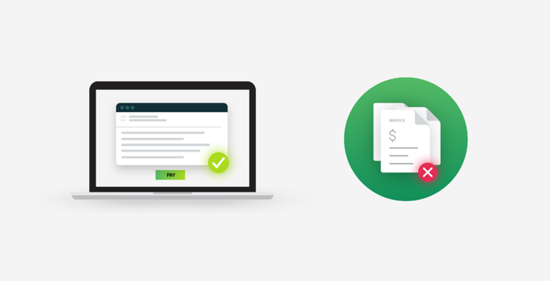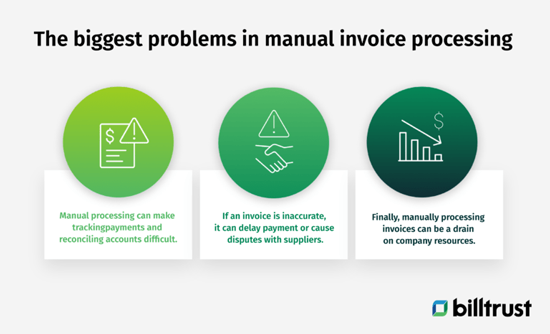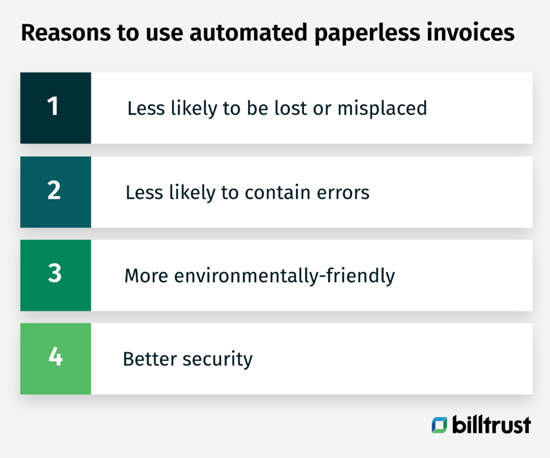In today's business world, it's more important than ever to streamline processes and reduce the potential for human error. One area where this is especially crucial is invoicing.
Invoicing helps you keep track of expenses and ensure that you're getting paid for the services or products and carries the potential to streamline your payment process when automated. Unfortunately, many businesses still rely on paper invoices, leading to missed payments and errors.
The solution? Paperless invoicing.
Why? Digital invoices not only reduce missing invoices and errors but carry many additional advantages, including making managing your business accounts a breeze.
Read on to discover how paperless invoicing can help you reduce missing invoices and errors in your business.

What does "invoice missing" mean?
An invoice, typically sent by a seller to a buyer, details the goods or services provided and the related costs. The invoice may also include other important information, such as payment terms or discounts.
When an invoice is "missing," it means that the company does not have a record of the payment. This could also mean that the seller has not received payment for the goods or services provided. Ultimately, it means they’re not getting paid for their work for the buyer. For the buyer, it means they're not receiving the total value of their purchase.
There are a few different reasons why invoices may go missing:
- If you send invoices by regular mail, there's always the possibility that they could get lost in the shuffle.
- If you send invoices electronically, there's a chance that they could get caught in spam filters or deleted by accident.
- Do you use a third-party billing service? There's always the possibility of human error.
- The customer may have lost track of the bill. This can happen if the customer has moved address or changed contact details, making it difficult for the business to contact them.
- In other cases, customers may deliberately avoid paying an invoice if they dispute the charges or are unhappy with the product or service.
Why is invoice tracking so crucial?
When a customer fails to pay an invoice, it can be costly and frustrating for your business. It means that customers have not paid for their goods or services, but it can also create a major headache when it comes time to do your taxes.
Regardless of the reason for missing invoices, they are a significant inconvenience.
Fortunately, you can take a few steps to reduce the chances of missing invoices:
- First, contact the vendor and confirm that they do not have a payment record.
- Once verified, you can make a copy of the invoice and send it along with your payment. It's also good to keep a copy of the invoice for your records.
- Add a contact name and phone number if the recipient has any questions.
- Finally, consider using an automated payment processing service that automatically sends reminders if an invoice is unpaid.
Whatever the reason for non-payment, you'll want to safeguard your business by taking steps to follow up on any outstanding invoices as quickly as possible. By doing so, you can minimize the financial impact of late payments and protect your cash flow.
Download the ultimate guide to digital accounts receivable

What are the biggest problems in invoice processing
Invoice processing is a vital but often overlooked part of business operations and many invoices get still get processed manually, leading to a host of problems.
What makes paper invoices so tricky?
From matching purchase orders to verifying pricing and quantities, there are countless opportunities for mistakes when you manually process your invoices:
- Manual paper invoicing can be a time-consuming and error-prone task.
- Manual processing can make tracking payments and reconciling accounts difficult.
- If an invoice is inaccurate, it can delay payment or cause disputes with suppliers.
- Finally, manually processing invoices can be a drain on company resources.
As businesses continue to grow, the problems with invoice processing are only likely to become more pronounced. In particular, businesses will need to find ways to deal with increasing volumes of invoices and sophisticated invoicing fraud schemes that can strike a disorganized system. Fortunately, solutions are available to help your business move past cumbersome manual processing.

How do you avoid missing invoices?
Any business owner or manager knows that invoicing can be a cumbersome process. Though invoicing may seem straightforward, it involves many moving parts in sending out invoices and ensuring on time payment.
Invoicing involves keep track of many moving parts, including recent payments and outstanding items to calculate late fees and interest. And if an error occurs, it can take time and cause frustration to fix it. This can often lead to invoice problems, such as missing payments or incorrect amounts being paid.
Luckily, there are a few simple steps you can take to avoid invoice problems in the first place:
- First, make sure that you have a clear and concise invoice template. This will help you avoid mistakes and ensure that all relevant information is included.
- Establish a clear and concise automated invoicing system to solve these issues. This system should include clear instructions on generating an invoice, who is responsible for sending it out, and when payments are due.
- Proofread your invoices carefully before sending them out. This will help ensure that all of the information is correct and that there are no typos or other errors. Plus, it's a best practice to send professional invoices.
- Send invoices after a completed job. This will help to prevent any confusion or payment delays.
- Establish a designated point person responsible for following up on late or missing payments.
- Use automated invoice tracking software or online tools. These can help you track what's been paid and what's still owed, making it easier to spot discrepancies.
- Be clear and concise in your communication with customers. If they're not sure about something on their invoice, they're less likely to pay it. You may even consider discussing payment options, including accepting online payments.
- Finally, follow up with clients who have not yet paid their invoices. A polite reminder can often be enough to prompt payment.
The case for paperless invoicing
In the digital age, it's hard to imagine a business that doesn't rely on electronic invoicing. Reducing missing invoices and errors is critical for businesses of all sizes, and implementing a paperless invoice system can help you achieve this goal. After all, going paperless leads to more efficiency and better for the environment, right?
Here are just a few reasons why you should consider automated paperless invoices:
- First, paperless invoices are less likely to be lost or misplaced as they’re not physically stored in a central location, usually in a filing cabinet or office drawer.
- Second, automated paperless invoices are less likely to contain errors. This is because they harness the power of automation, eliminating human mistakes.
- Third, paperless invoices are a more environmentally-friendly way to conduct business.
- Finally, paper invoices provide security and peace of mind that electronic invoicing software, such as BPN, simply can't match. They can't be hacked or deleted, meaning that your financial records are always safe.
In a world where paperless transactions are becoming the norm, many businesses are still struggling to make the switch. Switching to paperless invoicing, however, can help reduce these costly mistakes by reducing missing invoices and errors.

Final Thoughts
No one likes to miss a bill, but it can happen to even the most organized team. This could be because the invoice was never received, or the payment was never processed. Either way, missing invoices are a serious issue leading to late fees and interest charges. It’s essential to track down the missing invoice and resolve the issue as soon as possible so that you can get paid on time or even paid faster.
The solution?
Going paperless.
In addition, one of the most important aspects of running a successful business is maintaining a steady cash flow. Automated paperless invoicing can help with this. By investing in the right tools and processes, your company can ensure effective invoice management and avoid the costly mistakes that may occur. Thankfully, automated invoice processing helps your business avoid these problems by streamlining your invoice processing and reducing errors.

